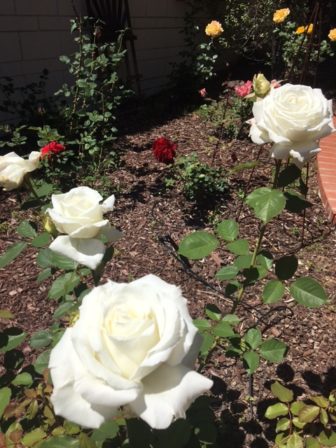Roses: Lost and Found

Today’s roses probably originated in China 5,000 years ago.
Last February, John Bagnasco spoke of his passion for roses. Having been in the horticulture world for over 50 years, Bagnasco began with a horticulture degree from Michigan State University. He went on to work at various nurseries, and in the 1990s became a head rose buyer for Armstrong Garden Centers. A friend asked why he didn’t grow roses at home. Bagnasco says, “It’s one of my obsessions now – preserving rose genetics for future generations.” Bagnasco is a published author, has taught horticulture both Palomar College and San Diego State, and cohosts and is president of the syndicated “GardenLife Radio Show.” We learned a great deal about roses at the meeting.
Bagnasco began by recommending a book from 1872, A Book about Roses by Reverend S. Reynolds Hole. He showed us a quote, which reflects his feelings, “The Heart-Gardener makes a garden wherever plants will grow, and finds something beautiful, go where he may.”
Hole explains that while he was arrived in London for a lengthy stay, he saw a flower girl selling roses from an enormous bunch. He bought one, and he felt as if that rose summoned his roses to tell him to leave London and go home to them. This he did, rosebud in his jacket, and spent the evening where he “exulted in my liberation from smuts and smell, and in all the restful peace, and the fragrant beauty which glowed around me…”
Bagnasco showed us photos of famous rose gardens, giving us bits of history with the photos. John says that Anthony Elgin, a mystery writer, is a good source of rose history. His series, “English Garden Mysteries,” features roses. The stories are fiction, but the horticulture is fact.
One source of old roses was Vintage Gardens. Its history began before there was a nursery. Greg Lowry writes, “…a group of old rose lovers created a non-profit organization to preserve the collection of roses that I developed with Phillip Robinson beginning in the late 1970’s.” Searching abandoned home sites, old graveyards, farms, and nurseries. Vintage Gardens began as Greg Lowry’s backyard nursery, specializing in old roses in 1985. His rose collection was opened to visitors in 1989, and their first catalogue came out in 1992. In 1994 he opened his first retail store in Sebastopol, and two years later relocated to a bigger site to make room for other historic plants. In 2006 Greg closed the retail store and returned to being a mail order old-rose nursery. In 2013 the recession forced him to close. He had rescued and restored ancient roses from various sites before the Garden Conservancy began working, but Friends of Vintage Roses and the Heritage Rose foundation are working to stabilize and restore this collection of over 5000 old and rare roses.
Another garden we learned of is Il Roseto Botanico, owned by Carla Fineschi. She has been collecting roses over 30 years. Her garden is one of the largest private collections of roses in the world with more than 6,500 individual varieties, each represented by a single plant. Her garden is a living museum tracing the history of the rose from antiquity to the present day.
Although there are fossils of roses 35 million years ago, today’s roses probably originated in China 5,000 years ago. During Roman times they were probably grown in the Middle East. Eventually they spread all over the Northern Hemisphere. They were used as legal tender and as symbols. Cultivated roses were introduced to Europe from China in the late 1700s. Cuba has many Chinese related roses. Other growers have crossed Chinese roses with Europeans in hopes of creating a hybrid better than either parent. No roses are native to the southern hemisphere.
In the United States, the oldest rose garden is Wyck Garden in Philadelphia. It has been in the same family since 1820. This garden contains many antique roses, which were believed to be lost forever. Some may have been planted in the 18th century. One rose, Rosa alba semi-plena, dates to before 1629 and may have been the House of York’s rose during the War of the Roses in England. Another old rose, Celsiana, is believed to have been growing since about 1750. Another rose found in Wyck’s Garden is Rosa Mondi, which has been cultivated since the Crusades. It is also known as the Apothecary Rose as historically it had medicinal properties.
It is comforting to know, particularly if one is no longer a spring chicken, that there are people hoping to preserve that which is old or nearly extinct.
The Mission Hills Garden Club do not meet in July and August, but we will meet again on September 27 at 4070 Jackdaw from 6 to 8 p.m. It will also be the time to renew your Garden Club membership.
Category: Local News







